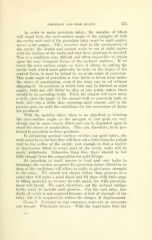Page 677 - My FlipBook
P. 677
POBCELAIN AKD GOLD INLAYS. 335
In order to make porcelain inlays, the margins of which
will stand best, the cavo-surface angle of the margins of both
the cavity wall and of the porcelain inlay must be right angles,
never acute angles. This requires tliat in the prei^aration of
the cavity, the dentin and enamel walls be cut at right angles
with the surface of the tooth and that these shall not be beveled.
This is a condition very difficult and often impossible to obtain
upon the very irregular forms of the occlusal surfaces. If we
bevel the cavo-surface angle, or leave it obtuse in cutting the
cavity wall, which must generally ))e done on the slopes of the
central fossa, it must be joined by an acute angle of porcelain.
This acute angle of porcelain is very liable to break away under
the stress of mastication, even if the inlay can be set without
chipping it. In positions in which both may be finished at right
angles, both are still liable to chip at any point, rmless there
should be no occluding tooth. First, the cement will wear away
a little, then the angle of the enamel wall or porcelain wall, or
both, will chip a little, thus exposing more cement, and so the
process goes on until the conditions for the recurrence of decay
are produced.
With the metallic inlay, there is no objection to beveling
the cavo-surface angle, as the margins of cast gold are very
strong, can be more closely fitted and can be depended upon to
stand the stress of mastication. They are, therefore, to be pre-
ferred to porcelain in these positions.
In preparing occlusal surface cavities for gold inlays, the
walls must be so cut that they will flare out a little from the pulpal
wall to the orifice of the cavity, just enough so that a matrix
or impression fitted to every part of the cavity walls will be
easily withdrawn. Otherwise than this, there should be but
little change from the preparation for gold fillings.
As porcelain in small masses is frail and very liable to
breakage, the cavities prepared for porcelain inlays should be as
deep as the conditions will allow, in order to give more strength
to the inlay. We should not simply follow deep grooves to a
point that will make a good finish and fill these with little arms
of filling material, as we may do with metal, for, with porcelain,
these will break. We must, therefore, cut the occlusal surface
boldly away to include such grooves. For the cast inlay, this
depth of cavity is not required because of lack of strength of the
inlay, but it is required to reduce the danger of displacement.
Class 2. Cavities in the proximal surfaces of bicuspids
AND molars. Porcelain inlays. With the experience thus far
44.-1


